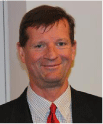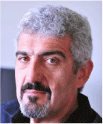Special issue dedicated to Professor Glen Deacon
Peter C. Junk A * and George Koutsantonis BA College of Science and Engineering, James Cook University, Townsville, Qld 4811, Australia.
B Chemistry, M310, School of Molecular Sciences, The University of Western Australia, Crawley, WA 6009, Australia.

Peter Junk completed his PhD in 1988 under the supervision of Colin Raston at The University of Western Australia. He obtained a DSc from James Cook University for his international reputation in organometallic chemistry of the main group and rare earth elements. After a short stint in the petroleum industry, Peter held several postdoctoral positions, with Jerry Atwood at the University of Alabama, Allan White at UWA and Glen Deacon at Monash University. In 1997, Peter joined James Cook University as a Lecturer. He moved to Monash University in 2001 where he was promoted to Professor. In 2012, he moved back to James Cook University as the Nevitt Professor of Chemistry. His main research interests are in rare earth and main group organometallic, organoamido and aryloxo chemistry, but has applied interests in corrosion inhibition. He has published in excess of 450 publications and reviews. He has been a recipient of the Burrows Award, and the Terrae Rarae award for recognition of his contributions to Rare Earth Chemistry. He is currently on the College of Experts at the ARC. |

George Koutsantonis is a synthetic chemist with an interest in functional materials that contain metals. He is a graduate of the University of Adelaide where he obtained his BSc(Hons) and PhD degree, the latter under the supervision of Michael Bruce. He began his scientific life studying the coordination properties and reactions of alkynes and often returns to this fascinating area. He undertook a postdoctoral position at the University of Kentucky. After a fruitful period in the USA, he returned to Australia on an inaugural ARC Postdoctoral Fellowship at Griffith University in 1991. In Brisbane, still essentially an inorganic chemist, worked with Main Group hydrides of Group 13. He was appointed to the staff at the University of Western Australia in 1995, where he remains as Professor. In Perth, he established an independent research programme in organometallic and inorganic chemistry. His work in this area was recognised by the joint award of the RACI Organometallic Award. He is currently Co-editor in Chief of the Australian Journal of Chemistry. When not working, he is an enthusiastic amateur cabinetmaker and has for many years exhibited purebred German Shorthaired Pointers under the Dürers prefix. |
Australian Journal of Chemistry 75(9) 493-494 https://doi.org/10.1071/CHv75n9_FO
Published: 16 September 2022
© 2022 The Author(s) (or their employer(s)). Published by CSIRO Publishing.
This special issue of Australian Journal of Chemistry is dedicated to the stellar career of Professor Glen Deacon from Monash University.
Glen Berenger Deacon was born in Adelaide on Thursday, 7 May 1936. He grew up in Hawthorn, an inner city suburb of Adelaide, and attended Westbourne Park Primary and Unley High Schools.
Glen completed his BSc(Hons) at the University of Adelaide in 1958 and then his PhD (supervised by Professor Bruce West) at the University of Adelaide in 1962, with his thesis entitled ‘Derivatives and Reactions of Group VB Organometalloidal and Quaternary Compounds’. In 1962, Glen did some postdoctoral studies at the University of Adelaide before embarking to England for a Postdoctoral Fellowship at University College London with Professor Sir Ronald Nyholm between 1963 and 1965.
Glen joined the School of Chemistry at Monash University in 1966, and it marked the start of a long and illustrious relationship with the University. He was promoted to Senior Lecturer in 1970, awarded a DSc from the University of Adelaide in 1972, promoted to Reader at Monash in 1975 and then to a Personal Chair at Monash in 1994. He was made a Fellow of the Royal Australian Chemical Institute in 1975, and is currently an Emeritus Professor at Monash.
When Glen joined Monash, his enthusiasm for teaching and research immediately took hold. Many students were drawn to study with him, and over the course of his career he has supervised more than 50 PhD graduates who went on to occupy senior positions in Australian and international industry and government departments.
During his career, he has developed strong research links with industry, SX Holdings, Mayne Pharma, DBL/Faulding, Warman International and CSL, to name a few. He is a major partner in more than 50 research funding grants amounting to many millions of dollars, and has international recognition for his contributions to inorganic chemistry, particularly in the field of organometallic compounds, predominantly (but not limited to) involving main group and rare earth elements. He has a great interest in developing new methods of synthesis, and the Deacon Reaction (Organometallics, 2012, 31, 1801), a synthetic method involving desulfonation for main group organometallics, developed in the 1970s, is named after him, but also pioneering synthesis of rare earth compounds from the metals, while garnering an extraordinary understanding of their reactivity. Glen has published in excess of 600 research papers in high-impact-factor journals, and continues to publish around 10 papers per annum. His work has been cited a staggering 25 800+ times and still registers around 1000 cites per annum. His highest cited paper was published in 1980 and cites still exceed 160 per annum. This paper has been cited over 5400 times, while his second highest cited paper has been cited in excess of 3000 times.
Glen continues to be in demand as a conference speaker both at home and abroad. His contribution to the world of science and academia has been recognised by the many accolades and honours bestowed on him, including the Burrows Award for the top Inorganic Chemist in Australia and New Zealand and the Terrae Rarae Award for his outstanding contributions to Rare Earth Chemistry. Glen was a member of the ARC College of Experts 2002–2004. As mentioned, he is a Fellow of the Royal Australian Institute of Chemistry.
Outside of science, Glen has keen interests in train systems, having completed many treks along historic train lines across Australia and other parts of the world, including Germany and the UK. He is totally absorbed by most sports, having been a keen cricket bowler in younger years, while still terrorising his PhD students on the squash court up to about 10 years ago. His encyclopaedic knowledge of sports is astounding, and if one ever needs to know any statistics of almost any sport, they should contact Glen.
This special issue compiles a large number of manuscripts submitted by many friends, colleagues and collaborators around the world and acknowledges the far and wide spread of Glen’s influence.


